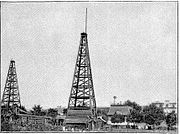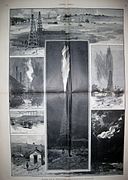
George Westinghouse Jr. was a prolific American inventor, engineer, and entrepreneurial industrialist based in Pittsburgh, Pennsylvania who is best known for his creation of the railway air brake and for being a pioneer in the development and use of alternating current (AC) electrical power distribution. During his lifetime, he received 362 patents for his inventions, and established 61 companies, many still in existence today.

East Pittsburgh is a borough in Allegheny County, Pennsylvania, United States, approximately 11 miles (18 km) southeast of the confluence of the Monongahela and the Allegheny rivers at Pittsburgh. The population in 1900 stood at 2,883, and in 1910, at 5,615. As of the 2020 census, the borough population was 1,927, having fallen from 6,079 in 1940. George Westinghouse erected large works there which supplied equipment to the great power plants at Niagara Falls and for the elevated and rapid-transit systems of New York City. Nearby, the George Westinghouse Bridge over Turtle Creek is a prominent fixture in the area, which is very near the borough of Braddock.

West Homestead is a borough in Allegheny County, Pennsylvania, United States, 8 miles (13 km) southeast of Pittsburgh, on the Monongahela River. Heavy industries associated with nearby steel mills existed here, such as axle works, brickworks, and manufactories of machinery, car wheels, etc. The largest concern was Mesta Machinery, which was one of the world's leading industrial manufacturers from 1898 until 1983. The population was 1,872 at the 2020 census.

The history of Pittsburgh began with centuries of Native American civilization in the modern Pittsburgh region, known as Jaödeogë’ in the Seneca language. Eventually, European explorers encountered the strategic confluence where the Allegheny and Monongahela Rivers meet to form the Ohio, which leads to the Mississippi River. The area became a battleground when France and Great Britain fought for control in the 1750s. When the British were victorious, the French ceded control of territories east of the Mississippi.

The Westinghouse Electric Corporation was an American manufacturing company founded in 1886 by George Westinghouse and headquartered in Pittsburgh, Pennsylvania. It was originally named "Westinghouse Electric & Manufacturing Company" and was renamed "Westinghouse Electric Corporation" in 1945. Through the early and mid-20th century, Westinghouse Electric was a powerhouse in heavy industry, electrical production and distribution, consumer electronics, home appliances and a wide variety of other products. They were a major supplier of generators and steam turbines for most of their history, and was also a major player in the field of nuclear power, starting with the Westinghouse Atom Smasher in 1937.

The Allegheny Portage Railroad was the first railroad constructed through the Allegheny Mountains in central Pennsylvania. It operated from 1834 to 1854 as the first transportation infrastructure through the gaps of the Allegheny that connected the midwest to the eastern seaboard across the barrier range of the Allegheny Front. Approximately 36 miles (58 km) long overall, both ends connected to the Pennsylvania Canal, and the system was primarily used as a portage railway, hauling river boats and barges over the divide between the Ohio and the Susquehanna Rivers. Today, the remains of the railroad are preserved within the Allegheny Portage Railroad National Historic Site operated by the National Park Service.

Allegheny Cemetery is one of the largest and oldest burial grounds in Pittsburgh, Pennsylvania. It is a historic rural cemetery.

Allegheny City was a municipality that existed in the U.S. state of Pennsylvania from 1788 until it was annexed by Pittsburgh in 1907. It was located north across the Allegheny River from downtown Pittsburgh, with its southwest border formed by the Ohio River, and is known today as the North Side. The city's waterfront district, along the Allegheny and Ohio rivers, became Pittsburgh's North Shore neighborhood.
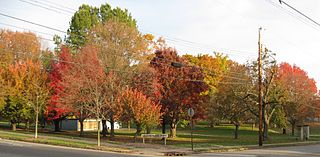
North Point Breeze is a mostly residential neighborhood that is located in the East End of Pittsburgh, Pennsylvania. It has a zip code of 15208, and representation on Pittsburgh City Council by the council member for District 9.
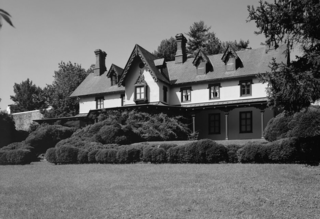
The Grange Estate, also known as Maen-Coch and Clifton Hall, is a historic mansion built by Henry Lewis Jr. (1671–1730) in Havertown, Pennsylvania, near Philadelphia. Parts of the residence are incorporated in the carriage house.

The Allegheny County Courthouse in downtown Pittsburgh, Pennsylvania, is part of a complex designed by H. H. Richardson. The buildings are considered among the finest examples of the Romanesque Revival style for which Richardson is well known.

George Westinghouse Memorial Bridge in East Pittsburgh, Pennsylvania, carries U.S. Route 30, the Lincoln Highway, over the Turtle Creek Valley near to where it joins the Monongahela River Valley east of Pittsburgh. The reinforced concrete open-spandrel deck arch bridge has a total length of 1,598 feet (487 m) comprising five spans. The longest, central span is 460 feet (140 m), with the deck height 240 feet (73 m) above the valley floor, for a time the world's longest concrete arch span structure. It cost $1.75 million. The design engineers were Vernon R. Covell and George S. Richardson, with architectural design by Stanley Roush. The pylons at the ends of the bridges feature Art Deco reliefs by Frank Vittor.

Allegheny Islands State Park is a 43-acre (17 ha) Pennsylvania state park in Harmar Township, Allegheny County, Pennsylvania in the United States. The undeveloped park is composed of three alluvial islands located in the middle of the Allegheny River northeast of Pittsburgh. The islands are just north of the boroughs of Oakmont and Plum, and southwest of Cheswick. Bridges for the Pennsylvania Turnpike and the Bessemer and Lake Erie Railroad Branch of the Canadian National Railway cross the Allegheny River at the middle island.

Frederick John Osterling was an American architect, practicing in Pittsburgh from 1888.

Turtle Creek is a 21.1-mile-long (34.0 km) tributary of the Monongahela River that is located in Allegheny and Westmoreland counties in the U.S. state of Pennsylvania. Situated at its juncture with the Monongahela is Braddock, Pennsylvania, where the Battle of the Monongahela was fought in 1755.
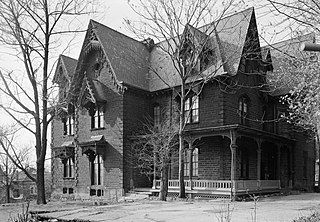
The John F. Singer House is a house in Wilkinsburg, Pennsylvania, United States, an east-side suburb of Pittsburgh. It was built for John F. Singer, who was made wealthy during the American Civil War by supplying the Union Army with iron and steel.
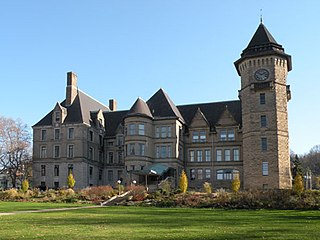
The Westinghouse Air Brake Company General Office Building in Wilmerding, Pennsylvania is a building from 1890. It was listed on the Pittsburgh History and Landmarks Foundation in 1975, National Register of Historic Places in 1987. Originally built as an office building for the Westinghouse Air Brake Company, it housed the George Westinghouse Museum from 2006 to 2016. In 2016 it was sold to the Priory Hospitality Group with the intention of being developed into a boutique hotel. However, the 2020 global pandemic affected those plans and it was announced in November 2021 that the building will be used for an art academy and to house classrooms for the Westinghouse Arts Academy, a nearby high school.
Vernon R. Covell was an American engineer. He was chief engineer of the Allegheny County Public Works Department.

George Sherwood Richardson (1896–1988) was an American engineer known for his elegant bridges, innovative construction techniques and skillful planning of highways. Designer of many bridges in the Pittsburgh and Allegheny County areas in the 20th century, he has been called "the dean of Pittsburgh bridge engineers".

The Westinghouse Interworks Railway was a short line railroad that operated in the lower Turtle Creek valley east of Pittsburgh, Pennsylvania. A subsidiary of the Westinghouse Electric Corporation, the railway used former Turtle Creek Valley Railroad tracks that Westinghouse rebuilt and extended from Trafford through Wilmerding to East Pittsburgh along the right bank of the creek. The railroad transported freight between the Westinghouse plants and also tested and demonstrated electric rail cars.





